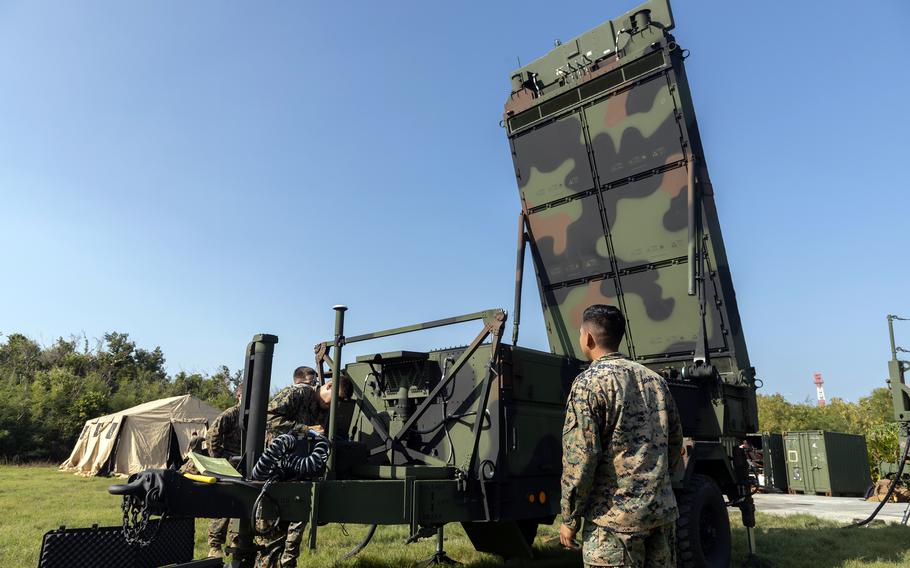
Marine Corps aviation radar technicians prepare the AN/TPS-80 Ground/Air Task Oriented Radar for training at Naval Base White Beach, Okinawa, Dec. 7, 2023. (Emily Weiss/U.S. Marine Corps)
CAMP FOSTER, Okinawa — The Marine Corps for the first time has deployed a state-of-the-art radar system during training this week on Japan’s westernmost island.
Members of 12th Marine Littoral Regiment, 3rd Marine Division, deployed an AN/TPS-80 Ground/Air Task Oriented Radar on Yonaguni, an island 67 miles east of Taiwan, as part of the Resolute Dragon exercise, according to a spokesman for the III Marine Expeditionary Force.
The Japan Air Self-Defense Force delivered the radar, which is designed to defend troops against aerial attacks, in a Kawasaki C-2 transport plane, 1st Lt. Owen Hitchcock wrote in an email Wednesday.
He would not say what day the radar was delivered, citing operational security; however, NHK Okinawa reported it arrived Monday.
The radar is on the island for the first time, a Japan Ground Self-Defense Force Staff Office spokesman said by phone Wednesday.
Some officials in Japan may speak to the media only on condition of anonymity.
It will be used for “vigilance and surveillance training,” according to a Yonaguni town news release. Seventy Japanese troops and 110 Marines are taking part in the exercise on the island.
The radar will complement the Japanese army’s “maritime targeting assets” and will “enhance our collective ability to defend Japan,” Hitchcock wrote.
The U.S. and Japan are increasing their cooperation as China increases its military strength and asserts its claims on maritime territory in the South and East China seas.
Yonaguni, part of Okinawa prefecture, is the closest inhabited Japanese territory to Taiwan.
Resolute Dragon comes as the Marine Corps exercises its Force Design initiative to counter China more effectively. This includes capabilities, such as the new radar system, to help it better defend the small islands east of Taiwan.
“III MEF is optimally postured to provide the broader stand-in force capability to conduct sensing and targeting to defend allies and partners within the first island chain,” Hitchcock said.
A stand-in force is a unit equipped and trained to operate within an adversary’s range of fire.
Resolute Dragon, hosted by the III Marine Expeditionary Force and the Ground Self-Defense Force, aims to improve coordination between Marines and Japanese troops, with a focus on aircraft, ground forces and live-fire training.
The exercise, now in its fourth year, involves more than 3,000 Marines and sailors and spans from Okinawa, Japan’s southernmost prefecture, to the island of Kyushu and southern Honshu, the largest of Japan’s four main islands.
The AN/TPS-80 radar can detect, identify and track airborne threats across 360 degrees, according to manufacturer Northrop Grumman. The multimission radar entered full production for the Marines in June 2019 to replace five other single-mission radars.